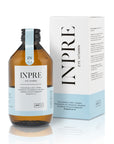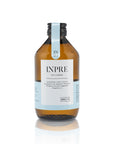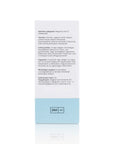



EYE VITAMIN
Age-related macular degeneration (AMD) is an atrophic disease of the yellow spot (macula) on the retina of the eye. It typically appears around the age of 60. It is the most common cause of vision loss (blindness) among the population of Europe and the USA. According to surveys, the latter approx. In 20 years, the frequency of this has increased by 500 (five hundred) %. Public health forecasts do not expect a favorable turn for approx. until 2040. This is partly attributable to our lifestyle (we live in much less natural light and watch more TV, telephones and monitors), and partly to our modern eating habits (we eat preserved foods and industrial bakery products at the expense of fresh vegetables and fruits - natural antioxidants).
The disease is caused by the accumulation of harmful effects of free radicals that come into contact with the eye during life. Blue (telephone, TV, computer monitor, some artificial light sources, etc.) and ultraviolet light promote the formation of free radicals on the fundus of the eyes. The processing of preserved foods, fats, sugars and sugary soft drinks used in food industry bakery products also lead to increased free radical production. Over the years, the eye-damaging effect of free radicals adds up and can cause gradual atrophy of the eye's spot. The liposomal antioxidant active ingredients of EYE VITAMIN are stored in the tissues of the eye after excellent absorption. In this way, they can immediately fight free radicals, protecting the tissues of the eye from chemical damage. The skin and seeds of red grape varieties (Vitis vinifera) have long been a recognized source of antioxidants. The proanthocyanidin content of its pressed oil protects vision, reduces eye fatigue and eye inflammation caused by inadequate light. It can slow down the onset and progression of age-related macular degeneration. It also lowers cholesterol and reduces cardiovascular risks. Black cranberry (Vaccinium myrtillus) is the oldest eye-improving agent used in Anép medicine. According to research, not without merit. The anthocyanin content improves the blood supply to the tissues of the eye, strengthens visual acuity and twilight vision. Its other active ingredients catalyze enzymes that help the energy balance of the cells of the eye sensor. The fresh dried fruit is recognized as a plant active ingredient in VIII. In the Hungarian Pharmacopoeia. Lutein and zeaxanthin: two yellow plant pigments with strong antioxidant effects. Both names refer to the Latin and Greek meaning of the color "yellow". The human body cannot produce any of them, so we get them entirely through nutrition. They are stored in the macula of the eye - thus determining its yellow color: macula lutea. A place of sharper vision that is locally protected against free radicals. Alutein is mostly of vegetable origin (spinach, kale, turnips, broccoli, zucchini, corn and green peas), but the egg yolk contains an exceptionally significant amount. Zeaxanthin is the pigment of yellow-red colored fruits and vegetables (oranges, carrots, pumpkins, etc. and also egg yolks). Their absorption varies greatly depending on their origin. Studies have shown that among those who regularly consume vegetables and fruits containing alutein-zeaxanthin, eye fundus atrophy is half as common as among those who only occasionally consume it. However, another study also confirmed that a diet rich in lutein-zeaxanthin approx. the course of the disease improved in three months. Lycopene is also a red pigment with an antioxidant effect. Its interesting feature is that it is heat-resistant, which is why it is present in higher concentrations in tomato sauce, ketchup, rosehips and sommelier than in fresh fruit (it thickens). In addition to supporting eyesight and eye health, a series of other beneficial effects have been proven in reducing cardiovascular risk, reducing the incidence of colon tumors, preventing prostate hyperplasia and tumors, etc. Azastaxanthin, a pigment from the freshwater alga Haematococcus pluvialis. It is one of the most powerful antioxidants found in nature and protects the nerve cells from oxidative stress. Fish that eat algae are also mentioned as a food source: salmon, trout, etc. Its beneficial effect in age-related macular atrophy has been proven. Vitamin E is also a fat-soluble antioxidant, which in this case protects the cell walls of the nerve membrane of the eye and eye cells against free radical damage. Its natural sources are oilseeds (walnuts, flaxseeds, hazelnuts, almonds, sunflowers), as well as the oils pressed from them, as well as olives. Green leafy vegetables (salads) and various cereal sprouts also contain smaller, but not insignificant, amounts. Azo lecithin, in addition to being an emulsifier of completely natural origin, released from the breakdown of liposomes, serves as a nutrient for brain neurons. Observations in social homes confirmed its beneficial effect on mental freshness.
The liposomal production technology means that the active ingredient particles are individually packed in a shell with a similar structure to the biological membranes of the body. On the one hand, this provides protection to the active ingredients, and on the other hand, being similar to cell walls and membranes, it dissolves in them and delivers its contents to the target cells without hindrance. 96% of the active ingredient formulated in this way reaches the target cells for utilization. On the other hand, conventionally produced or even natural active ingredients can only reach the place of their utilization, the cell organelles of the target cells, with loss. As a result, more significant protection can be achieved with smaller doses and more convenient dosing.
Risk factors for macular atrophy and vision loss in old age: A) Non-controllable risk factors: Most common in Caucasian (white) people. Age: around 60 years of age. Family history: the disease occurs among ancestors or blood relatives. B) Influenceable risk factors: Overweight (especially abdominal fat), association with diabetes and/or high blood pressure, smoking, exposure to artificial light, prolonged viewing of monitors, exposure to UV light - possibly without protective equipment. One-sided nutrition (low consumption of fresh vegetables, fruits and natural foods, in favor of preserved foods; regular industrial pastry or fat consumption.) The presence of two or more of the above factors means an increased risk of age-related macular degeneration. In such a case, from the age of 40, it is worthwhile to pay extra attention to the elimination of influenceable risk factors, and to consciously do something to preserve vision in old age.
The recommended daily dose is 1 x 5 ml (one measuring cup or approx. teaspoon). Gently shake the bottle, then fill the portion. It can be consumed alone or mixed with any liquid (drinking water, tea, fruit juice, etc.), at any time of the day. It does not contain added sugar. Diabetics can also consume it. A 300 ml net filling weight, sealed with a safety ring cap, labeled plastic bottle contains a two-month dose. Stored in the original sealed bottle in a dark place, protected from sunlight and radiant heat, it preserves its quality until the deadline indicated on the packaging. After opening, it is recommended to refrigerate and consume within 3 months. Store away from children. During storage, sediment may form at the bottom of the bottle, which is a natural phenomenon - it does not affect the quality of the product. Shake gently before filling. The EYE VITAMIN liposomal liquid food supplement is safe and has no side effects when used as prescribed. Do not exceed the recommended daily dose. It contains ingredients of soy origin, so it should be avoided if you have a soy allergy. A large overdose may cause osmotic diarrhea accompanied by abdominal cramps. This usually does not require medical intervention and does not represent a health risk. Suppressing diarrhea with symptomatic agents is not advisable. The sooner the unnecessary soy lecithin is eliminated, the sooner the complaint will disappear! The consumption of EYE VITAMIN does not replace medical care and screening tests, nor the protection of eyes that may be exposed to UV light or strong sunlight. Dietary supplements do not replace a varied, balanced diet and a healthy lifestyle. This review was written for general information purposes by Dr. Csaba Gothárd, physician, dietary supplement consultant. It does not serve to diagnose or treat diseases and does not replace medical care or screening tests.




